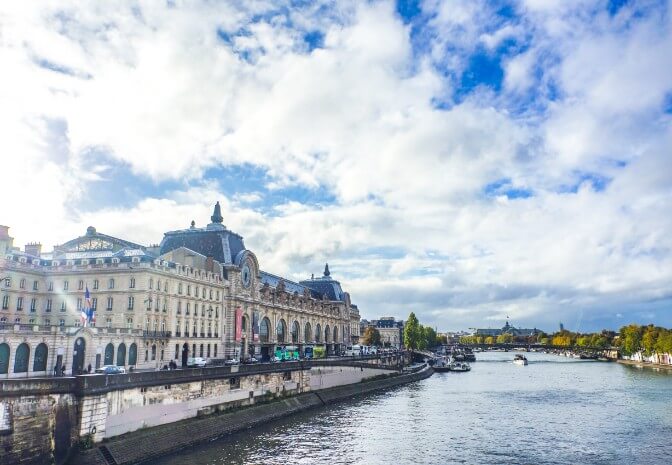Immerse yourself in culture from the safety of your sofa by reading all about three unmissable paintings on display in Paris’ Musée d’Orsay, and try out a virtual tour of the museum too!
Set on the Left Bank of the Seine in Paris, the Musée d’Orsay is a striking building full of impressive art pieces to discover. Originally a train station, the Gare d’Orsay, which was opened for the 1900 Universal Exposition, the museum is now home to paintings, sculptures, photography, decorative arts, and furniture.
Here, we take a look at three unmissable paintings that you can find during a visit to the Musée d’Orsay.
Bal du Moulin de la Galette – Pierre Auguste Renoir

The Bal du Moulin de la Galette, or Dance at the Moulin de la Galette, painting is one of Renoir’s most celebrated pieces, and depicts a lively cafe and outdoor dance hall in Paris’ vibrant Montmartre district. The scene shows people enjoying drinks and socialising while a dance takes place in the background, and the way that it’s painted makes you feel like you’re part of the action. When Renoir created this oil painting in 1876, he used vivid colours and a focus on light which really made it stand out. Although it seems that many of the people in the piece are wearing black, on close inspection you’ll find that these dark tones are actually created using a clever mix of colours.
The Moulin de la Galette has an interesting history itself, and has actually been the inspiration behind paintings by Van Gogh and Picasso too. The 17th century moulin (windmill) located on the site originally produced flour, but was bought out in 1809 and the flour was milled and used to make galettes (a specialist brown bread) from then on. To begin with, a cup of milk would be provided with each galette, and this was replaced with a glass of wine over time, which transformed the mill into a much-loved cabaret. It’s this buzzing atmosphere that you can see when you admire the Bal du Moulin de la Galette in the Musée d’Orsay.
Self-Portrait – Vincent Van Gogh

Vincent Van Gogh painted over 30 self portraits within a decade, and you can see how he grows as an artist with each one. Self-Portrait, which hangs in the Musée d’Orsay, was created in 1889 and is thought to be the last example that Van Gogh painted before he died. Self portraits were important to Van Gogh, as they enabled him to improve on his skills at a time when he couldn’t afford to hire models. Despite many self portraits being painted, it is thought that this one is the artist’s best.
The painting’s swirled background is believed to show how Van Gogh felt at the time of painting, and medical professionals have even said that they think it was painted while the artist was in a psychotic state. Comparisons have been made between this style of background and the one in another of Van Gogh’s paintings, ‘The Starry Night’, which is also displayed in the Musée d’Orsay. The choice of colours is also important, as although cool blues and greens are often thought to be calming tones, they form a striking contrast with the figure’s red hair and beard. Despite the sporadic background, Van Gogh has painted himself with great control, and a particular focus on the eyes which really draw the viewer in.
Blue Water Lilies – Claude Monet

Water lilies may be the first things that come to mind when you think about Claude Monet, as the painter created a whole series of artworks based on this specific plant. In the Blue Water Lilies piece, which you can see at the Musée d’Orsay, Monet focuses on the lily pads themselves – unlike in his other pieces. When he began painting water lilies, Monet would include the horizon and other surroundings but, over time, he almost zoomed in on the plant until everything else disappeared. With the pond taking up the entire canvas, it almost gives the impression that the water goes one forever, especially as the piece remains to be unframed.
Monet loved his Giverny home and gardens, and they provided the inspiration for all of his works from the 1910s until his death in 1926. He rented the property until he could afford to purchase it and, from then on, the gardens grew with his wealth. Eventually, he had a team of gardeners who looked after the area for him, but he always provided them with detailed plans of how he wanted everything to look. His aquatic garden was one of his biggest motivators, and he had water lilies from France, Egypt, and South America. In fact, the council weren’t happy with Monet’s introduction of foreign water lilies as they thought they might contaminate the water. However, he refused to move them, much to the delight of those who admire his paintings today.
While you’re waiting for the Musée d’Orsay to reopen, why not treat yourself to a virtual tour? Don’t forget to keep your eye out for these three impressive paintings while you explore!



